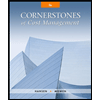
a.
Calculate the net realizable value of Beta-1 for the year ended November 30.
a.
Answer to Problem 68P
The net realizable value for Beta-1 is $375,000.
Explanation of Solution
Net realizable value method:
Net realizable value method is used to allocate the cost in the proposition of their net realizable market value at the split-off point. If the product can be sold at the split-off point then the selling price of that product at a split-off point is used as the base for the calculation of cost allocation.
Calculate the net realizable value for Beta-1:
Thus, the net realizable value for Beta-1 is $375,000.
Working note 1:
Calculate the unit produced for Beta-1:
Working note 2:
Calculate the price per unit for Beta-1:
There is no further processing for the Beta-1, so the sales value at the split-point should be used.
b.
Calculate the joint costs for the year ended November 30 to be allocated.
b.
Answer to Problem 68P
The joint cost for the year ended November 30 is $1,050,000.
Explanation of Solution
Cost allocation:
Cost allocation is the process of distributing the common cost of the production and service rendered to the various departments of the business. It is used to calculate the actual cost attributed to a specific department.
Calculate the joint cost for the year ended November 30:
| Particulars | Amount |
| Cost of alpha-11 | $720,000 |
| Direct labor | $180,000 |
| Manufacturing | $150,000 |
| Total joint costs | $1,050,000 |
Table: (1)
The joint cost will consider all the costs to the split-off point.
Thus, the joint cost for the year ended November 30 is $1,050,000.
c.
Calculate the cost of Beta-2 sold for the year ended November 30.
c.
Answer to Problem 68P
The total cost of the Beta-2 is $705,000.
Explanation of Solution
Cost allocation:
Cost allocation is the process of distributing the common cost of the production and service rendered to the various departments of the business. It is used to calculate the actual cost attributed to a specific department.
Calculate the cost allocation of Beta-2:
| Particulars | Amount |
| Allocation to Beta-2(3) | $210,000 |
| Direct labor | $337,500 |
| Manufacturing overhead | $157,500 |
| Total cost of Beta-2 | $705,000 |
Table: (2)
Thus, the total cost of the Beta-2 is $705,000.
Working note 3:
Calculate the joint cost allocation to Beta-2:
Working note 4:
Calculate the total net realized value of the company:
| Particulars | Amount |
| Net realizable value of Beta-1 | $375,000 |
| Net realizable value of Beta-2 | $225,000(5) |
| Net realizable value of Beta-3 | $525,000(6) |
| Total net realized value | $1,125,000 |
Table: (3)
Working note 5:
Calculate the net realizable value of Beta-2:
| Particulars | Amount |
| Sales value | $720,000 |
| Less: direct labor | $337,500 |
| Less: manufacturing overhead | $157,500 |
| Net realized value | $225,000 |
Table: (4)
Working note 6:
Calculate the net realized value of Beta-3:
| Particulars | Amount |
| Sales value | $1,417,500(7) |
| Less: direct labor | $487,500 |
| Less: manufacturing overhead | $405,000 |
| Net realized value | $525,000 |
Table: (5)
Working note 7:
Calculate the sales value of Beta-3:
d.
Calculate the value of the ending inventory for Beta-1.
d.
Answer to Problem 68P
The value of ending inventory is $140,000 for Beta-1.
Explanation of Solution
Ending inventory:
Ending inventory unit is the units lying in the store due to its-non issuance in the current period. Ending inventory for the current period is the beginning inventory for the next period.
Calculate the ending inventory for Beta-1:
Thus, the value of ending inventory is $140,000.
Working note 8:
Calculate the units of ending inventory (unit):
Working note 9:
Calculate the units of ending inventory ($):
Want to see more full solutions like this?
Chapter 11 Solutions
Gen Combo Fundamentals Of Cost Accounting; Connect Access Card
- TOSHIBA ended the year with an inventory of $842,000. During the year, the firm purchased $5,467,000 of new inventory and the cost of goods sold reported on the income statement was $5,215,000. What was TOSHIBA's inventory at the beginning of the year?arrow_forwardCan you solve this general accounting question with accurate accounting calculations?arrow_forwardOn January 1, 2011, Phoenix Manufacturing purchased for $875,000, equipment having a useful life of eight years and an estimated salvage value of $67,500. Phoenix has recorded monthly depreciation of the equipment on the straight-line method. On December 31, 2018, the equipment was sold for $158,000. As a result of this sale, Phoenix Manufacturing should recognize a gain of___. Help me with thisarrow_forward
- Please provide the solution to this general accounting question using proper accounting principles.arrow_forwardKanye Ridge Industries has a beginning finished goods inventory of $24,300, raw material purchases of $31,500, cost of goods manufactured of $42,700, and an ending finished goods inventory of $18,900. The cost of goods sold for this company is?arrow_forwardGiven the solution and accounting questionarrow_forward
- Helparrow_forwardWhat is the result of this disposal transaction?arrow_forwardStriveTech Co. uses the high-low method to analyze cost behavior. The company observed that at 18,000 machine hours of activity, total maintenance costs averaged $28.00 per hour. When activity increased to 22,000 machine hours (still within the relevant range), the average total cost per machine hour dropped to $25.00. Based on this information, the fixed cost was:arrow_forward
 Managerial Accounting: The Cornerstone of Busines...AccountingISBN:9781337115773Author:Maryanne M. Mowen, Don R. Hansen, Dan L. HeitgerPublisher:Cengage Learning
Managerial Accounting: The Cornerstone of Busines...AccountingISBN:9781337115773Author:Maryanne M. Mowen, Don R. Hansen, Dan L. HeitgerPublisher:Cengage Learning Cornerstones of Cost Management (Cornerstones Ser...AccountingISBN:9781305970663Author:Don R. Hansen, Maryanne M. MowenPublisher:Cengage Learning
Cornerstones of Cost Management (Cornerstones Ser...AccountingISBN:9781305970663Author:Don R. Hansen, Maryanne M. MowenPublisher:Cengage Learning

